| Listing 1 - 7 of 7 |
Sort by
|
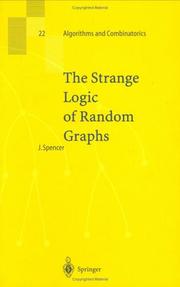
ISBN: 3540416544 3642074995 3662045389 9783540416548 Year: 2001 Volume: 22 Publisher: Berlin Springer
Abstract | Keywords | Export | Availability | Bookmark
 Loading...
Loading...Choose an application
- Reference Manager
- EndNote
- RefWorks (Direct export to RefWorks)
The study of random graphs was begun by Paul Erdos and Alfred Renyi in the 1960s and now has a comprehensive literature. A compelling element has been the threshold function, a short range in which events rapidly move from almost certainly false to almost certainly true. This book now joins the study of random graphs (and other random discrete objects) with mathematical logic. The possible threshold phenomena are studied for all statements expressible in a given language. Often there is a zero-one law, that every statement holds with probability near zero or near one. The methodologies involve probability, discrete structures and logic, with an emphasis on discrete structures. The book will be of interest to graduate students and researchers in discrete mathematics.
Discrete mathematics --- Random graphs --- Logic, Symbolic and mathematical --- Graphes aléatoires --- Logique symbolique et mathématique --- Logic, symbolic and mathematical --- Logic, Symbolic and mathematical. --- Random graphs. --- Graphes aléatoires --- Logique symbolique et mathématique --- Graphes, Théorie des. --- Graphes aléatoires. --- Graph theory --- Discrete mathematics. --- Combinatorics. --- Computers. --- Computer science—Mathematics. --- Discrete Mathematics. --- Theory of Computation. --- Mathematics of Computing. --- Automatic computers --- Automatic data processors --- Computer hardware --- Computing machines (Computers) --- Electronic brains --- Electronic calculating-machines --- Electronic computers --- Hardware, Computer --- Computer systems --- Cybernetics --- Machine theory --- Calculators --- Cyberspace --- Combinatorics --- Algebra --- Mathematical analysis --- Discrete mathematical structures --- Mathematical structures, Discrete --- Structures, Discrete mathematical --- Numerical analysis --- Graphes, Théorie des --- Graph theory. --- Logique mathematique --- Logique du premier ordre
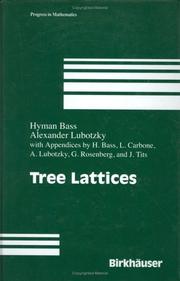
ISBN: 0817641203 3764341203 9780817641207 1461274133 146122098X Year: 2001 Volume: v. 176 Publisher: Boston : Birkhäuser,
Abstract | Keywords | Export | Availability | Bookmark
 Loading...
Loading...Choose an application
- Reference Manager
- EndNote
- RefWorks (Direct export to RefWorks)
Group actions on trees furnish a unified geometric way of recasting the chapter of combinatorial group theory dealing with free groups, amalgams, and HNN extensions. Some of the principal examples arise from rank one simple Lie groups over a non-archimedean local field acting on their Bruhat—Tits trees. In particular this leads to a powerful method for studying lattices in such Lie groups. This monograph extends this approach to the more general investigation of X-lattices G, where X-is a locally finite tree and G is a discrete group of automorphisms of X of finite covolume. These "tree lattices" are the main object of study. Special attention is given to both parallels and contrasts with the case of Lie groups. Beyond the Lie group connection, the theory has application to combinatorics and number theory. The authors present a coherent survey of the results on uniform tree lattices, and a (previously unpublished) development of the theory of non-uniform tree lattices, including some fundamental and recently proved existence theorems. Non-uniform tree lattices are much more complicated than uniform ones; thus a good deal of attention is given to the construction and study of diverse examples. The fundamental technique is the encoding of tree action in terms of the corresponding quotient "graphs of groups." Tree Lattices should be a helpful resource to researcher sin the field, and may also be used for a graduate course on geometric methods in group theory.
Trees (Graph theory) --- Lie groups. --- Arbres (Théorie des graphes) --- Groupes de Lie --- Arbres (Théorie des graphes) --- Geometry. --- Discrete mathematics. --- Group theory. --- Algebra. --- Ordered algebraic structures. --- Topological groups. --- Combinatorics. --- Discrete Mathematics. --- Group Theory and Generalizations. --- Order, Lattices, Ordered Algebraic Structures. --- Topological Groups, Lie Groups. --- Combinatorics --- Algebra --- Mathematical analysis --- Groups, Lie --- Lie algebras --- Symmetric spaces --- Topological groups --- Groups, Topological --- Continuous groups --- Algebraic structures, Ordered --- Structures, Ordered algebraic --- Mathematics --- Groups, Theory of --- Substitutions (Mathematics) --- Discrete mathematical structures --- Mathematical structures, Discrete --- Structures, Discrete mathematical --- Numerical analysis --- Euclid's Elements
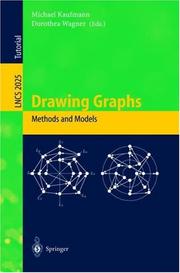
ISSN: 03029743 ISBN: 3540420622 3540449698 9783540420620 Year: 2001 Volume: 2025 Publisher: Berlin, Heidelberg : Springer Berlin Heidelberg : Imprint: Springer,
Abstract | Keywords | Export | Availability | Bookmark
 Loading...
Loading...Choose an application
- Reference Manager
- EndNote
- RefWorks (Direct export to RefWorks)
Graph drawing comprises all aspects of visualizing structural relations between objects. The range of topics dealt with extends from graph theory, graph algorithms, geometry, and topology to visual languages, visual perception, and information visualization, and to computer-human interaction and graphics design. This monograph gives a systematic overview of graph drawing and introduces the reader gently to the state of the art in the area. The presentation concentrates on algorithmic aspects, with an emphasis on interesting visualization problems with elegant solutions. Much attention is paid to a uniform style of writing and presentation, consistent terminology, and complementary coverage of the relevant issues throughout the 10 chapters. This tutorial is ideally suited as an introduction for newcomers to graph drawing. Ambitioned practitioners and researchers active in the area will find it a valuable source of reference and information.
Computer science --- Artificial intelligence. Robotics. Simulation. Graphics --- Computer graphics --- Graph theory --- Technology - General --- Engineering & Applied Sciences --- Computer graphics. --- Graph theory. --- Graphs, Theory of --- Theory of graphs --- Automatic drafting --- Graphic data processing --- Graphics, Computer --- Extremal problems --- Mathematics. --- Information technology. --- Business --- Algorithms. --- Discrete mathematics. --- Combinatorics. --- Discrete Mathematics. --- Algorithm Analysis and Problem Complexity. --- Mathematics of Computing. --- Computer Graphics. --- IT in Business. --- Data processing. --- Computer art --- Graphic arts --- Electronic data processing --- Engineering graphics --- Image processing --- Digital techniques --- Combinatorial analysis --- Topology --- Computer software. --- Computer science. --- IT (Information technology) --- Technology --- Telematics --- Information superhighway --- Knowledge management --- Combinatorics --- Algebra --- Mathematical analysis --- Informatics --- Science --- Software, Computer --- Computer systems --- Computer science—Mathematics. --- Business—Data processing. --- Algorism --- Arithmetic --- Discrete mathematical structures --- Mathematical structures, Discrete --- Structures, Discrete mathematical --- Numerical analysis --- Foundations
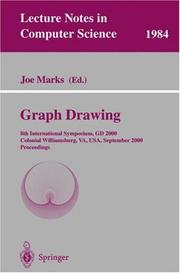
ISSN: 03029743 ISBN: 3540415548 3540445412 9783540415541 Year: 2001 Volume: 1984 Publisher: Berlin, Heidelberg : Springer Berlin Heidelberg : Imprint: Springer,
Abstract | Keywords | Export | Availability | Bookmark
 Loading...
Loading...Choose an application
- Reference Manager
- EndNote
- RefWorks (Direct export to RefWorks)
This year’s meeting marked the Eighth International Symposium on Graph D- wing. The organizing and program committees worked hard to make this year’s symposium possible, and we were delighted that so many people came to - lonial Williamsburg, Virginia, for three days of the latest results in the eld of graph drawing. As in previous years, the review process was quite competitive. We accepted 30 out of 53 regular-length submissions, and 5 out of 15 short submissions, for a total acceptance ratio of 35 out of 68, or 51%. This year’s program featured several new developments in the eld. Four di erent approaches for handling very large graphs were presented in a session on force-directed layout. Two sessions were devoted to the latest advances in orthogonal graph drawing. And alongside the usual mix of theory and practice papers we had several contributions based on empirical studies of users and of systems. Our invited talks were given by two speakers who were new to most members of the GD community, but who work in areas that are closely related to graph drawing. Professor Colin Ware of the University of New Hampshire told us how knowledge of human visual perception is useful for the design of e ective data visualizations. And Professor David Jensen of the University of Massachusetts at Amherst talked about the process of knowledge discovery from graphs, a process that involves more than just graph drawing and visualization.
Computer graphics --- Graph theory --- Technology - General --- Engineering & Applied Sciences --- Computer science. --- Computers. --- Algorithms. --- Computer science --- Computer graphics. --- Discrete mathematics. --- Combinatorics. --- Computer Science. --- Algorithm Analysis and Problem Complexity. --- Discrete Mathematics. --- Theory of Computation. --- Computer Graphics. --- Discrete Mathematics in Computer Science. --- Mathematics. --- Computer software. --- Information theory. --- Computational complexity. --- Combinatorics --- Algebra --- Mathematical analysis --- Complexity, Computational --- Electronic data processing --- Machine theory --- Automatic drafting --- Graphic data processing --- Graphics, Computer --- Computer art --- Graphic arts --- Engineering graphics --- Image processing --- Communication theory --- Communication --- Cybernetics --- Software, Computer --- Computer systems --- Digital techniques --- Computer science—Mathematics. --- Automatic computers --- Automatic data processors --- Computer hardware --- Computing machines (Computers) --- Electronic brains --- Electronic calculating-machines --- Electronic computers --- Hardware, Computer --- Calculators --- Cyberspace --- Discrete mathematical structures --- Mathematical structures, Discrete --- Structures, Discrete mathematical --- Numerical analysis --- Algorism --- Arithmetic --- Foundations --- Computer graphics - Congresses --- Graph theory - Congresses
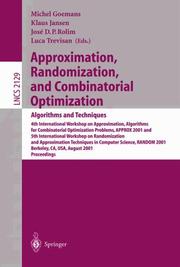
ISBN: 3540424709 3540446664 Year: 2001 Publisher: Berlin, Heidelberg : Springer Berlin Heidelberg : Imprint: Springer,
Abstract | Keywords | Export | Availability | Bookmark
 Loading...
Loading...Choose an application
- Reference Manager
- EndNote
- RefWorks (Direct export to RefWorks)
This book constitutes the joint refereed proceedings of the 4th International Workshop on Approximation Algorithms for Optimization Problems, APPROX 2001 and of the 5th International Workshop on Ranomization and Approximation Techniques in Computer Science, RANDOM 2001, held in Berkeley, California, USA in August 2001. The 26 revised full papers presented were carefully reviewed and selected from a total of 54 submissions. Among the issues addressed are design and analysis of approximation algorithms, inapproximability results, on-line problems, randomization, de-randomization, average-case analysis, approximation classes, randomized complexity theory, scheduling, routing, coloring, partitioning, packing, covering, computational geometry, network design, and applications in various fields.
Computer science --- Computer Science --- Engineering & Applied Sciences --- Statistical methods --- Informatics --- Mathematics. --- Computer programming. --- Algorithms. --- Numerical analysis. --- Mathematical analysis. --- Analysis (Mathematics). --- Discrete mathematics. --- Combinatorics. --- Analysis. --- Programming Techniques. --- Discrete Mathematics. --- Algorithm Analysis and Problem Complexity. --- Numeric Computing. --- Science --- Global analysis (Mathematics). --- Computer science. --- Computer software. --- Electronic data processing. --- Combinatorics --- Algebra --- Mathematical analysis --- ADP (Data processing) --- Automatic data processing --- Data processing --- EDP (Data processing) --- IDP (Data processing) --- Integrated data processing --- Computers --- Office practice --- Software, Computer --- Computer systems --- Analysis, Global (Mathematics) --- Differential topology --- Functions of complex variables --- Geometry, Algebraic --- Automation --- Algorism --- Arithmetic --- Discrete mathematical structures --- Mathematical structures, Discrete --- Structures, Discrete mathematical --- Numerical analysis --- Electronic computer programming --- Electronic data processing --- Electronic digital computers --- Programming (Electronic computers) --- Coding theory --- 517.1 Mathematical analysis --- Foundations --- Programming --- Numerical Analysis.
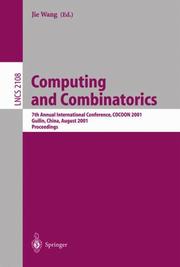
ISBN: 3540424946 3540446796 Year: 2001 Publisher: Berlin, Heidelberg : Springer Berlin Heidelberg : Imprint: Springer,
Abstract | Keywords | Export | Availability | Bookmark
 Loading...
Loading...Choose an application
- Reference Manager
- EndNote
- RefWorks (Direct export to RefWorks)
Computer science --- Combinatorial analysis --- Computer Science --- Engineering & Applied Sciences --- Mathematics. --- Computer communication systems. --- Computers. --- Algorithms. --- Computer graphics. --- Discrete mathematics. --- Discrete Mathematics. --- Theory of Computation. --- Algorithm Analysis and Problem Complexity. --- Discrete Mathematics in Computer Science. --- Computer Graphics. --- Computer Communication Networks. --- Information theory. --- Computer software. --- Computational complexity. --- Automatic drafting --- Graphic data processing --- Graphics, Computer --- Computer art --- Graphic arts --- Electronic data processing --- Engineering graphics --- Image processing --- Complexity, Computational --- Machine theory --- Software, Computer --- Computer systems --- Communication theory --- Communication --- Cybernetics --- Digital techniques --- Computer science—Mathematics. --- Communication systems, Computer --- Computer communication systems --- Data networks, Computer --- ECNs (Electronic communication networks) --- Electronic communication networks --- Networks, Computer --- Teleprocessing networks --- Data transmission systems --- Digital communications --- Electronic systems --- Information networks --- Telecommunication --- Cyberinfrastructure --- Network computers --- Algorism --- Algebra --- Arithmetic --- Automatic computers --- Automatic data processors --- Computer hardware --- Computing machines (Computers) --- Electronic brains --- Electronic calculating-machines --- Electronic computers --- Hardware, Computer --- Calculators --- Cyberspace --- Discrete mathematical structures --- Mathematical structures, Discrete --- Structures, Discrete mathematical --- Numerical analysis --- Distributed processing --- Foundations
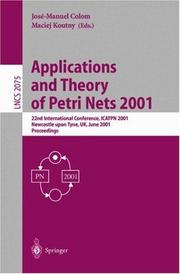
ISBN: 3540422528 3540457402 Year: 2001 Publisher: Berlin, Heidelberg : Springer Berlin Heidelberg : Imprint: Springer,
Abstract | Keywords | Export | Availability | Bookmark
 Loading...
Loading...Choose an application
- Reference Manager
- EndNote
- RefWorks (Direct export to RefWorks)
This volume contains the proceedings of the 22nd International Conference on Application and Theory of Petri Nets. The aim of the Petri net conferences is to create a forum for discussing progress in the application and theory of Petri nets. Typically, the conferences have 100{150 participants { one third of these coming from industry while the rest are from universities and research institutions. The conferences always take place in the last week of June. This year the conference was organized jointly with the 2nd International Conference on Application of Concurrency to System Design (ICACSD 2001). The two conferences shared the invited lectures and the social program. The conference and a number of other activities are co-ordinated by a steering committee with the following members: G. Balbo (Italy), J. Billington (Aust- lia), G. De Michelis (Italy), C. Girault (France), K. Jensen (Denmark), S. - magai (Japan), T. Murata (USA), C.A. Petri (Germany; honorary member), W. Reisig (Germany), G. Rozenberg (The Netherlands; chairman), and M. Silva (Spain). Other activities before and during the 2001 conference included tool dem- strations, a meeting on XML Based Interchange Formats for Petri Nets", - tensive introductory tutorials, two advanced tutorials on Probabilistic Methods in Concurrency" and Model Checking", and two workshops on Synthesis of Concurrent Systems" and Concurrency in Dependable Computing". The tu- rial notes and workshop proceedings are not published in these proceedings, but copies are available from the organizers.
Mathematics. --- Information technology. --- Business --- Computer communication systems. --- Software engineering. --- Mathematical logic. --- Computer science --- Mathematical Logic and Foundations. --- Software Engineering. --- Mathematical Logic and Formal Languages. --- Computer Communication Networks. --- Discrete Mathematics in Computer Science. --- IT in Business. --- Data processing. --- Petri nets --- Logic, Symbolic and mathematical. --- Computer science. --- Computational complexity. --- IT (Information technology) --- Technology --- Telematics --- Information superhighway --- Knowledge management --- Complexity, Computational --- Electronic data processing --- Machine theory --- Informatics --- Science --- Algebra of logic --- Logic, Universal --- Mathematical logic --- Symbolic and mathematical logic --- Symbolic logic --- Mathematics --- Algebra, Abstract --- Metamathematics --- Set theory --- Syllogism --- Computer software engineering --- Engineering --- Computer science—Mathematics. --- Business—Data processing. --- Communication systems, Computer --- Computer communication systems --- Data networks, Computer --- ECNs (Electronic communication networks) --- Electronic communication networks --- Networks, Computer --- Teleprocessing networks --- Data transmission systems --- Digital communications --- Electronic systems --- Information networks --- Telecommunication --- Cyberinfrastructure --- Network computers --- Distributed processing --- Machine theory. --- Computer networks. --- Discrete mathematics. --- Business information services. --- Formal Languages and Automata Theory. --- Business enterprises --- Information services --- Discrete mathematical structures --- Mathematical structures, Discrete --- Structures, Discrete mathematical --- Numerical analysis --- Computer mathematics --- Abstract automata --- Abstract machines --- Automata --- Mathematical machine theory --- Algorithms --- Logic, Symbolic and mathematical --- Recursive functions --- Robotics
| Listing 1 - 7 of 7 |
Sort by
|

 Search
Search Feedback
Feedback About
About Help
Help News
News